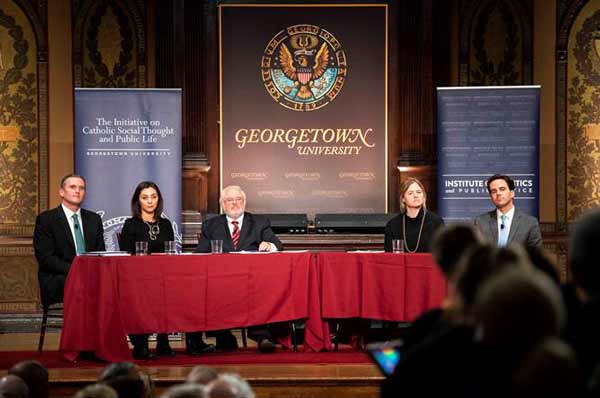
By Christopher White, The Tablet’s National Correspondent
WASHINGTON, D.C. – Two weeks after a Democratic “blue wave” swept Congress, Catholics gathered at Georgetown University to parse the role of the 73 percent of self-identified Christian voters who participated in the midterm elections.
During a discussion on Monday sponsored by the Initiative on Catholic Social Thought and Public Life on “Faith and the Faithful in the Midterm Elections,” executive director John Carr said it would be a mistake to ignore the influence faith holds over voters when they head to the polls.
A panel comprised of Robert Costa of the Washington Post, Elizabeth Dias of the New York Times, along with Ana Gonzalez-Barrera and Gregory Smith of the Pew Research Center, sought to make sense of that reality – and provide insight on what it might mean for an increasingly polarized and rapidly changing country.
In the immediate aftermath of the midterms, Costa said two things are clear: For the Republican party, the recent confirmation of Justice Brett Kavanaugh to the Supreme Court affirmed that courts remain the battlefield for religious voters.
Kavanaugh is the second Supreme Court pick by President Donald Trump, and the support of many religious voters are tied to his campaign pledge to appoint “pro-life justices.”
Further, Costa said that Democrats and Republicans agree that Congress is no longer the legislative battleground for cultural issues – such as abortion or marriage – and instead, those issues are now fought in state legislatures.
The support Trump has received from evangelicals and conservative Catholics alike has been a regular point of discussion among pundits – and continued to loom large during Monday night’s discussion.
Costa, who has covered Trump since before he kicked off his presidential campaign, said that “one thing you notice about President Trump is this is someone unlike any other Republican … Other candidates would virtue-signal. Candidate Trump never did that.”
While Trump would meet with religious leaders, Costa recalled, he would not engage.
To that point, Costa argued that religious leaders and voters alike didn’t care, because they had one thing on their mind: power.
“In a fast-changing culture, when the norms of their lives were changing, they wanted power,” he insisted.
Costa recalled his travels on the campaign trail where many voters would cite what they perceived to be threats to religious liberty or change in marriage laws, and “they wanted to put a stop to it.”
Trump’s message to these voters was simple: “Take a bet on me.”
Looking ahead to 2020, Costa said that Democratic strategists believe this may be their biggest opportunity to win over voters since the 1976 election of President Jimmy Carter.
They believe that in “the age of Francis,” more Catholics can be won over, particularly if abortion is not the primary issue for voters. He also added that while the president’s rhetoric on immigration may have provided a short-term benefit during the midterms, many Republicans fear the long-term costs of the party being perceived as anti-immigrant.
Those concerns were supported by Pew data from Gonzalez-Barrera who noted that Hispanics are “more enthusiastic” about voting than other demographic groups, be they Republican or Democratic.
Further, Hispanic and Latino voters are very young, with two-thirds of that population that voted in the midterms being under the age of 35.
While two-thirds lean Democratic, she warned that they are non-monolithic and that the minority that votes Republican is a strong subset.
Meanwhile, Dias, who spent time covering evangelical voters in a dozen states leading up to the midterms, spoke of the power of the white evangelical voting bloc.
While Democrats reveled in their dramatic takeover of the House of Representatives, she said that evangelicals were celebrating the fact that they kept the Senate – and with it, had their eyes set on getting a potential third Supreme Court justice appointed by Trump.
Yet despite the fact that evangelicals are, for the most part, tied to the Republican party, she pointed to the Senate race between Republican Ted Cruz and Democrat Beto O’Rourke in Texas, where many evangelicals, particularly women, cast their ballots in support of O’Rourke.
Abortion, Dias noted, continues to be the third rail for Democratic politicians. Despite the fact that Nancy Pelosi, likely to resume her post as Speaker of the House, has said the party needs to be more welcoming to pro-life voters, Dias said that structurally, “it’s still difficult.”
Smith, also drawing from Pew’s findings, noted that despite the fact there’s much discussion about how rapidly society is changing, when he looks at how religious groups vote, he’s struck by the continuity. For religious groups that tend to vote Republican, they continue to vote for Republican candidates, and the same is true among Democrats, he observed.
In the 2018 midterms, Catholics were split right down the middle – a contrast from the past two midterms where Catholics favored Republican candidates by 10 percent.
According to Smith, just as the country is politically polarized, religious groups themselves are deeply politically polarized. Based on his data, white Catholics are trending in a Republican direction and Latino Catholics are among the most strongly Democratic constituencies.
How priests, pastors, and bishops navigate this will be a delicate tightrope act in years to come, he noted.
Inside religious congregations, “sharing the same pew,” Smith said, “should at least be the starting point for a conversation.”
